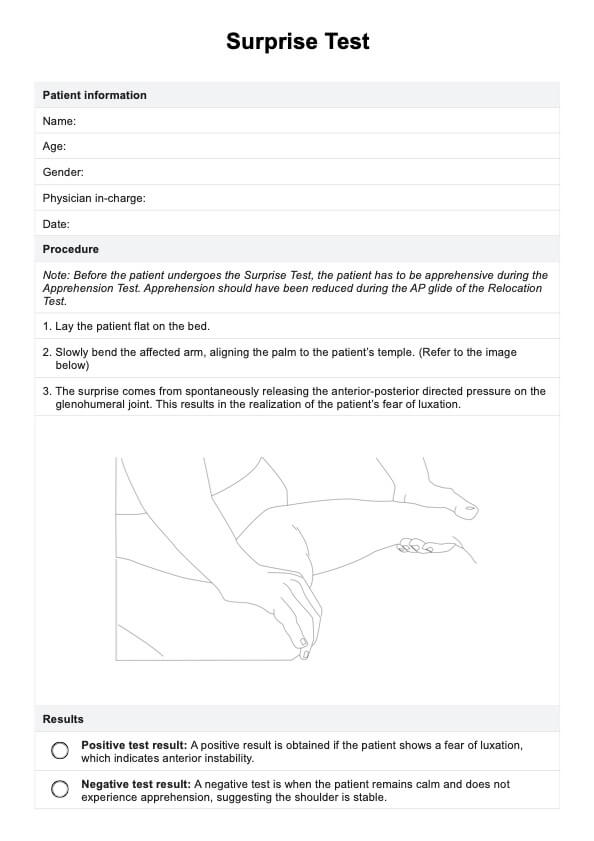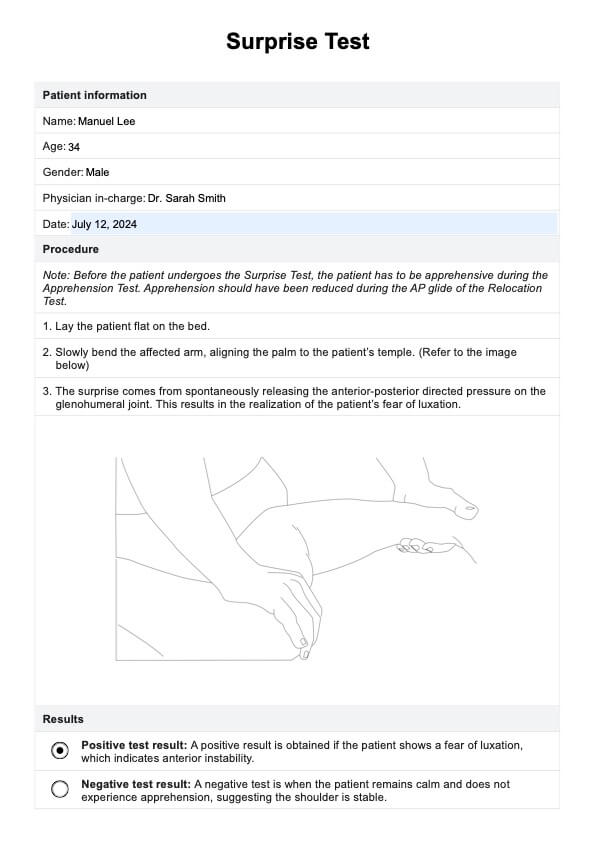Surprise Test
Download Carepatron's free Shoulder Release Test or Surprise Test PDF and enhance your test preparation with our resources.


What is a Surprise Test?
A Surprise Test, often used in diagnosing anterior shoulder instability, is a specific clinical assessment designed to evaluate the stability of the glenohumeral joint. This test, also known as the relocation test or release test, is performed to identify the presence of shoulder instability. During the Surprise Test, the patient's shoulder is placed in an external rotation and horizontal abduction position often called the apprehension test. At the end range of this motion, the examiner applies a posterior force to the shoulder, which can help alleviate pain and apprehension, indicating anterior instability.
The test concludes by suddenly releasing the applied force, which might lead to a return of symptoms such as pain or discomfort. This sudden change, or "surprise," can confirm the presence of anterior shoulder instability if the patient experiences a noticeable difference in their shoulder stability and pain levels.
Surprise Tests are highly specific and can be instrumental in diagnosing shoulder issues that are not always apparent in standard examinations. This method is particularly useful for patients experiencing unexplained shoulder pain or those who have had recurrent instability episodes. Accurate execution of this test on the last day of a clinical assessment can significantly enhance the understanding and management of shoulder conditions.
Is it the same as the relocation test?
The Surprise Test and the relocation test are closely related but not identical. Both are used to assess anterior shoulder instability by examining the stability of the glenohumeral joint. The relocation test involves placing the shoulder in an externally rotated and abducted position, often during the apprehension test, and then applying a posterior force to relieve symptoms of instability and pain. This maneuver helps confirm the presence of anterior instability by alleviating discomfort when the force is applied.
The Surprise Test, however, takes this assessment one step further. After the posterior force is applied during the relocation test, the examiner suddenly releases this force, creating a "surprise" for the patient. If the patient experiences a sudden return of pain or instability upon release, it further confirms the diagnosis of anterior shoulder instability. While the relocation test focuses on symptom relief with applied force, the Surprise Test emphasizes the response upon the sudden release of this force.
Surprise Test Template
Surprise Test Example
When is this test performed?
The Surprise Test is typically performed when a patient exhibits symptoms of shoulder instability, particularly anterior shoulder instability. It is used in clinical settings to evaluate the stability of the glenohumeral joint and to confirm the diagnosis of shoulder instability. This test is usually conducted during a physical examination after a thorough history-taking, especially if the patient reports recurrent episodes of shoulder pain or dislocations.
How to use this template for traumatic anterior glenohumeral instability
Carepatron's Surprise Test template is a valuable tool for healthcare professionals to assess traumatic anterior glenohumeral instability efficiently and accurately. This template provides a structured approach to performing and documenting the Surprise Test, ensuring consistency and reliability in clinical assessments. Here’s how to use the template effectively:
Step 1: Access the template
First, access the Surprise Test template by logging into your Carepatron account. Navigate to the template section and search for the "Surprise Test" template. Once found, you can open it and familiarize yourself with its layout and features.
Step 2: Review the template
Before using the template with a patient, review it thoroughly. Ensure you understand each section, from patient information to the specific steps of the Surprise Test. This will help you perform the test accurately and document the findings effectively.
Step 3: Use to assess for traumatic anterior glenohumeral instability
Follow the template’s instructions during the patient examination to perform the Surprise Test. Document each step and the patient’s reactions in the template.
Step 4: Evaluate and discuss test results with patient
After performing the test, use the template to evaluate the results. Note any signs of pain or instability that occurred during the release test. Discuss the findings with the patient, explaining the implications of any positive indicators for anterior shoulder instability.
Step 5: Monitor and provide education for patient
Use the template to plan follow-up care and education for the patient. Monitor their progress over time and provide guidance on managing their shoulder instability. The template can help track improvements or worsening conditions, ensuring a comprehensive approach to patient care.
Benefits of using Surprise Test on patients
Carepatron's Surprise Test in clinical practice offers several benefits for accurately diagnosing and managing anterior shoulder instability. Here are three key benefits:
Accurate diagnosis of anterior shoulder instability
The Surprise Test, performed after other initial tests, provides a highly specific method for diagnosing anterior shoulder instability. By combining external rotation, horizontal abduction, and a sudden force release, clinicians can observe clear signs of instability and pain.
Enhanced patient understanding
Using the Surprise Test allows healthcare professionals to effectively demonstrate the presence of shoulder instability to patients. When patients experience a noticeable change in their symptoms during the test, it provides a tangible understanding of their condition.
Improved treatment planning
The detailed insights gained from the Surprise Test enable clinicians to develop more targeted and effective treatment plans. Healthcare providers can tailor interventions to address the patient's unique needs by accurately identifying the severity and specifics of shoulder instability.
Commonly asked questions
The Surprise Test for physiotherapy assesses anterior shoulder instability by suddenly releasing a posterior force applied during external rotation and horizontal abduction. This maneuver helps identify instability if the patient experiences a return of pain or discomfort.
The test for anterior shoulder instability often involves the apprehension test followed by the relocation test and the Surprise Test. These tests help evaluate the stability of the glenohumeral joint and identify symptoms of instability.
A positive apprehension test for the shoulder occurs when the patient shows signs of fear, pain, or discomfort when the shoulder is placed in an externally rotated and abducted position. This reaction indicates potential anterior shoulder instability.
The special test for the shoulder commonly includes the apprehension test, relocation test, and Surprise Test, among others. These tests help assess various aspects of shoulder stability and identify specific conditions affecting the shoulder joint.







































































































